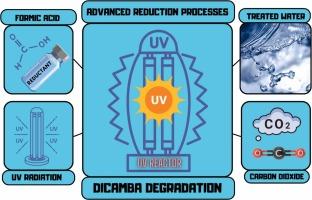作为一种高级还原工艺,甲酸和紫外线联合应用降解持久性除草剂麦草畏
IF 11.3
1区 环境科学与生态学
Q1 ENGINEERING, ENVIRONMENTAL
引用次数: 0
摘要
作为一种新型的高级还原过程(ARP),研究了紫外线和甲酸(FA)的联合应用对麦草畏这种持久性除草剂的降解作用。研究了甲酸浓度、溶解有机物和无机阴离子等关键参数的影响。当麦草畏浓度为 0.023 mM、FA 浓度为 0.123 M 时,紫外线和 FA(UV-FA)的组合可使麦草畏的降解率达到 97%,脱氯率达到 94%;在脱氯方面,当麦草畏浓度为 0.23 mM、FA 浓度为 0.123 M、pH 值为 2 时,ARP(UV-FA)和酸性条件下单独使用紫外线的脱氯率分别为 12.4 mg/L 和 5.2 mg/L。使用甲基紫精(MV2+)作为还原自由基(包括羧基阴离子自由基 (CO2●¯))的清除剂进行清除试验,氯化物浓度下降到 1.7 mg/L,揭示了该自由基在麦草畏脱氯过程中的重要性。无机阴离子(CO32¯ 和 SO42¯)对麦草畏的降解有轻微的正面影响,使降解率提高到 99%,而对脱氯的负面影响则分别为 7% 和 30%。由于溶解有机物(DOM)引起的浑浊,降解率下降了 39%,脱氯率下降了 30%。通过气相色谱-质谱(GC-MS)技术鉴定出的五种中间产物证实了所提出的麦草畏通过 ARP 降解的机理。麦草畏的还原降解主要由基于 CO2●¯ 的过程组成,包括单电子转移过程和自由基-亲核芳香族取代(SRN)反应,证明了该 ARP 有效降解麦草畏的能力。本文章由计算机程序翻译,如有差异,请以英文原文为准。

Degradation of dicamba – A persistent herbicide – By combined application of formic acid and UV as an advanced reduction process
The degradation of dicamba as a persistent herbicide was studied with the combined application of UV and formic acid (FA) as a novel advanced reduction process (ARP). The effects of key parameters of FA concentration, dissolved organic matter, and inorganic anions were studied. A 97 % degradation and 94 % dechlorination of dicamba were obtained through the combination of UV and FA (UV-FA) at a dicamba concentration of 0.023 mM and FA concentration of 0.123 M. With respect to the dechlorination, at a dicamba concentration of 0.23 mM, FA concentration of 0.123 M, and pH of 2, chloride concentration of 12.4 mg/L and 5.2 mg/L was obtained for ARP (UV-FA) and sole UV in acidic condition, respectively. Scavenging test using Methyl viologen (MV2 +) as a scavenger for reductive radicals including carboxyl anion radicals (CO2•¯) led to a decrease in the chloride concentration to 1.7 mg/L, revealing the importance of this radical in the dechlorination of dicamba. Inorganic anions (CO32¯ and SO42¯) had a slightly positive effect on the degradation of dicamba and led to an increase in degradation to 99 %, while they had a negative effect on the dechlorination by 7 % and 30 %, respectively. Due to the turbidity induced by dissolved organic matters (DOM), a moderate decrease in degradation by 39 % and dechlorination by 30 % was observed. The existence of five intermediates identified by GC-MS technique confirmed the proposed mechanism of dicamba degradation via ARP. Reductive degradation of dicamba mainly consists of processes based on CO2•¯, including single electron transfer process and radical-nucleophilic aromatic substitution (SRN) reactions, demonstrating the capability of this ARP for the effective degradation of dicamba.
求助全文
通过发布文献求助,成功后即可免费获取论文全文。
去求助
来源期刊

Journal of Hazardous Materials
工程技术-工程:环境
CiteScore
25.40
自引率
5.90%
发文量
3059
审稿时长
58 days
期刊介绍:
The Journal of Hazardous Materials serves as a global platform for promoting cutting-edge research in the field of Environmental Science and Engineering. Our publication features a wide range of articles, including full-length research papers, review articles, and perspectives, with the aim of enhancing our understanding of the dangers and risks associated with various materials concerning public health and the environment. It is important to note that the term "environmental contaminants" refers specifically to substances that pose hazardous effects through contamination, while excluding those that do not have such impacts on the environment or human health. Moreover, we emphasize the distinction between wastes and hazardous materials in order to provide further clarity on the scope of the journal. We have a keen interest in exploring specific compounds and microbial agents that have adverse effects on the environment.
 求助内容:
求助内容: 应助结果提醒方式:
应助结果提醒方式:


